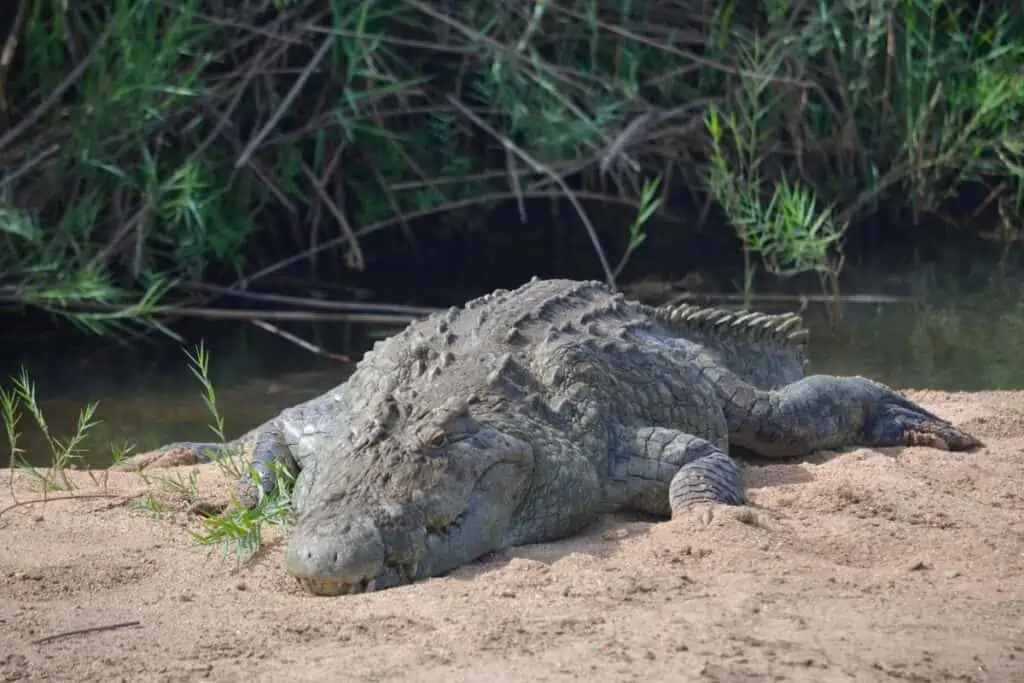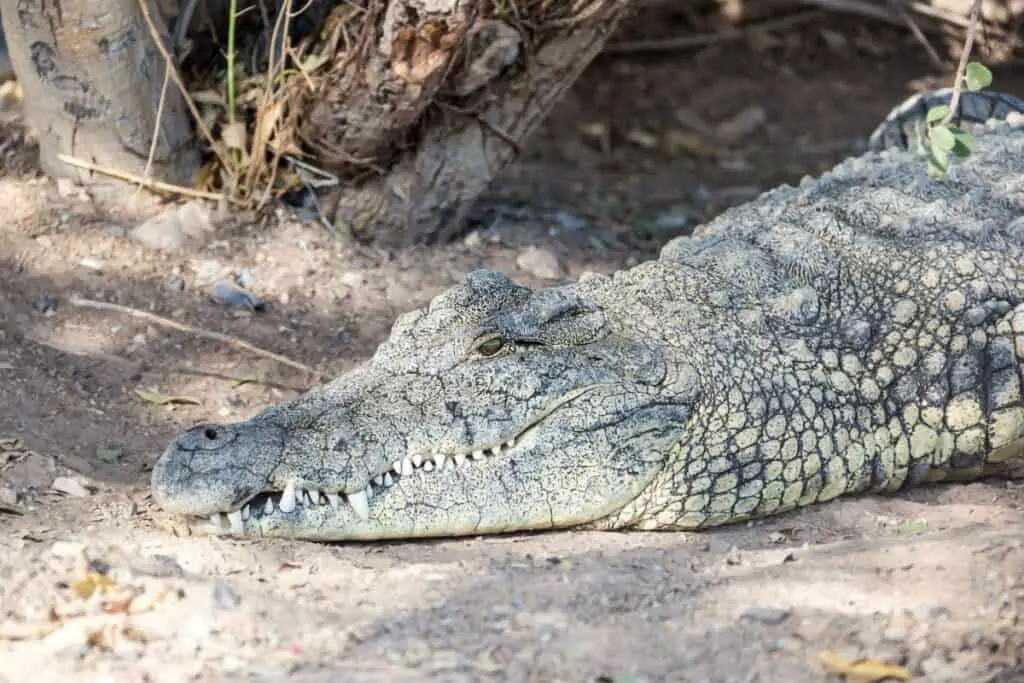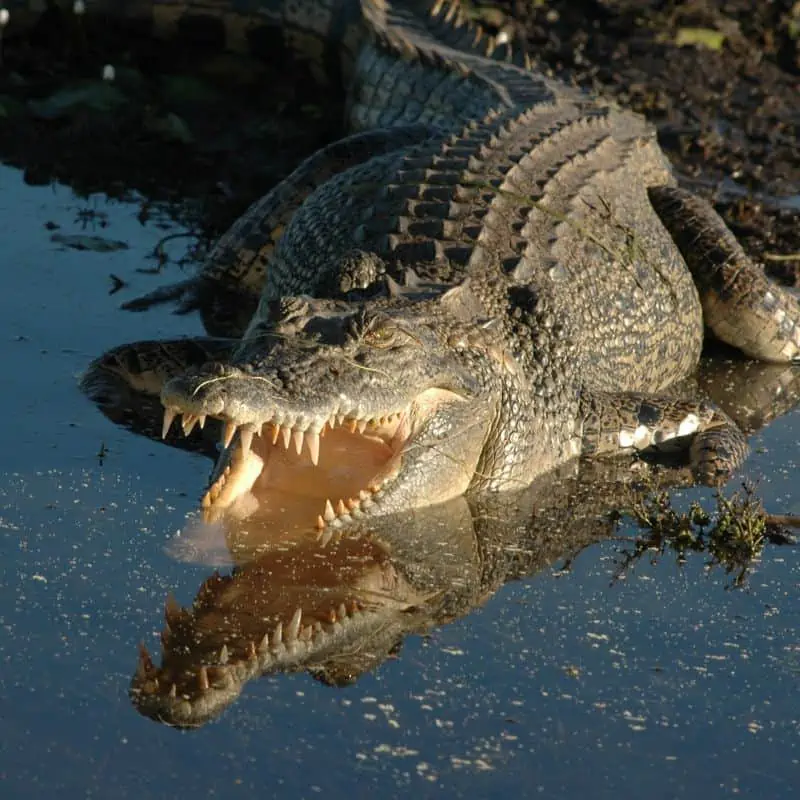The crocodile is hard to beat when it comes to animals that fascinate and terrify humans in equal measure. Extremely durable and often feared for their size and power, crocodiles are often believed to be immortal or immune to aging.
We can deny those claims immediately, but that still leaves the question, how long do crocodiles live then?
The average life expectancy of a crocodile is around 70 years, with some larger species, such as Saltwater crocodiles, able to live even longer. Saltwater crocodiles can live for over a century in captivity. Nile crocodiles typically reach 70, but smaller species average only between 30 to 40 years.
Crocodiles have a wide range of sizes and life expectancies, and they even managed to make it through the age of the dinosaurs. To better understand how old crocodiles can get, we consider their size, survival mechanisms, and the most frequent causes of their deaths.

How Long Do Crocodiles Live?
Not too long ago, there were claims on the internet that crocodiles don’t age, never cease growing, and may practically be immortal. The truth is, however, quite the opposite.
From the time they hatch, crocodiles face challenging lives and, as they grow older, suffer from the same incapacitating effects as other animals. Still, it remains true that certain crocodile species do live astonishingly long lives.
In general, larger crocodiles appear to live longer than smaller ones. As they are bulkier than females, male crocodiles have a longer life expectancy.
Some male crocodiles in captivity have been recorded as being over 100 years of age. Saltwater crocodiles in captivity can reach over 100 years old, while Nile crocodiles have frequently been observed to live up to 70.
In the wild, most crocodiles have a lifespan of between 25 and 70 years, but this differs widely between species.
Saltwater crocodiles in the wild tend to live around 70 years, and Nile crocodiles average between 50 and 60 years. But the average lifespan of smaller crocodiles is only about 30 to 40 years.
The table below gives the observed lifespan in years of common crocodile species in the wild:
| Crocodile Species | Expected Lifespan In The Wild (Years) |
|---|---|
| African Slender-snouted crocodile | 35 |
| American crocodile | 50-70 |
| Australian Freshwater crocodile | 40-60 |
| Borneo crocodile | 35-75 |
| Cuban crocodile | 50-75 |
| Dwarf crocodile | 40-75 |
| Morelet’s crocodile | 55-65 |
| Mugger crocodile | 30-44 |
| New Guinea crocodile | 24-60 |
| Nile crocodile | 50-60 |
| Orinoco crocodile | 60 |
| Philippine crocodile | 60 |
| Saltwater crocodile | 70 |
| Siamese crocodile | 35 |
How Can You Tell A Crocodile’s Age?
When you compare the size of two crocodiles, the larger one is usually older, but this doesn’t help with estimating their ages, and males tend to be larger than females.
Instead, the most common method used to determine a crocodile’s age is the lamellar growth ring measurement within a crocodile’s teeth and bones.
With the growth ring measurement method, naturalists count prominent bone growth zones, which roughly correspond to annual change-of-season growth spurts.
Using the lamellar growth ring measurement method allows for observations on the age of an individual crocodile or the average age of a species and how long each species tends to live.
How Large Do Crocodiles Get?
The most significant difference between crocodiles, alligators, and caimans, is the size discrepancy.
Crocodiles are substantially longer, wider, and heavier than caimans and alligators and will actively hunt these other species if they ever encounter them.
The average alligator or caiman grows up to 19 feet, while crocodiles can reach sizes of 25 feet on rare occasions.
Within the different crocodile species, there can also be significant size discrepancies. Crocodiles grow to an average length of between 16 and 23 feet, but the smallest crocodile species, the dwarf crocodile, only grows up to around 5 feet and usually weighs between 40 and 75 pounds.
Saltwater crocodiles grow to be the largest and can reach up to 23 feet and weigh up to 2600 pounds.
In addition to having large, muscular bodies, the jaws of the more sizeable specimens can output some impressive force. Large crocodiles can have a bite force of 3,700 psi, the strongest of any animal measured.

How Did Crocodiles Survive Past Extinction Events?
The size and appearance of crocodiles also tend to elicit thoughts of dinosaurs, who are their not-so-distant cousins. Crocodiles (or rather, their ancestors) survived the mass extinction events of the dinosaur past.
Due to their relative evolutionary refusal to change, crocodiles are pretty much unchanged from the dinosaurs they descended.
While most dinosaurs died out during the Cretaceous Extinction period after a massive meteor struck the Earth, crocodiles managed to pull through.
The prevailing theories relate to the ability of crocodiles to live for extended periods without needing food, keep low, and live near water.
The slower metabolism of crocodiles, combined with the fact that they mostly lived around inland water sources such as rivers and lakes or coastal areas, shielded them from starvation.
While scarce, smaller creatures in these areas survived by eating decaying plant matter were sufficient food for crocodiles.
What Are The Most Common Causes Of Crocodile Death?
Besides being eaten while still young, age-related degeneration is the most significant contributor to crocodile mortality rates.
As they grow older, crocodiles become weaker and begin to struggle with catching prey. Eventually, their teeth will stop regrowing, and they will inevitably starve.
Since they are cold-blooded, crocodiles rely on external heat sources to regulate their bodily functions.
Crocodiles can often be seen at the water’s edge when it is cold, bathing in the sun while actively seeking shade when temperatures are high. A crocodile may succumb to extreme temperatures if it cannot find sufficient shelter.

Crocodiles don’t have many predators since they have tough skin, large jaws, and a powerful bite force.
However, they sometimes conflict with animals such as hippopotamuses, elephants, and big cats, leading to the death of some crocodiles. Generally, such battles are too risky for both participants, so they prefer to avoid one another.
Only about an estimated 1% of crocodiles reach adulthood. Even when adult crocodiles seek to protect their offspring, there is no shortage of opportunistic animals that can snatch them up.
Predators such as snakes, monitor lizards, birds, opportunistic mammals, and other crocodiles frequently target crocodile eggs and hatchlings.
Pollution, habitat degradation, and human meddling may negatively affect the environments that crocodiles depend on, reducing their ability to hunt or breed.
Poisoned or poor-quality water may cause crocodiles to wander in search of better habitats, and they may encounter humans who kill them to protect their communities or livestock.
Final Thoughts On Crocodiles Lifespan
Crocodiles are usually aged by looking at the growth rings within their bones and teeth, with annual spurts reflected in their cellular composition.
Depending on their species, most live between 25 and 100 years, with an average life expectancy of around 70. Bulkier crocodiles tend to live longer than their smaller counterparts, with some Saltwater crocodiles in captivity reported as having ages over a century.
While many crocodiles perish before adulthood, those who live become fierce and awe-inspiring apex predators.
Crocodiles have an extensive menu of potential prey available to eat, making it possible for them to reach monstrous proportions.
When crocodiles can avoid conflict with humans, they become enormous killing machines who live long, fruitful, and bloody lives smiling all the while.

